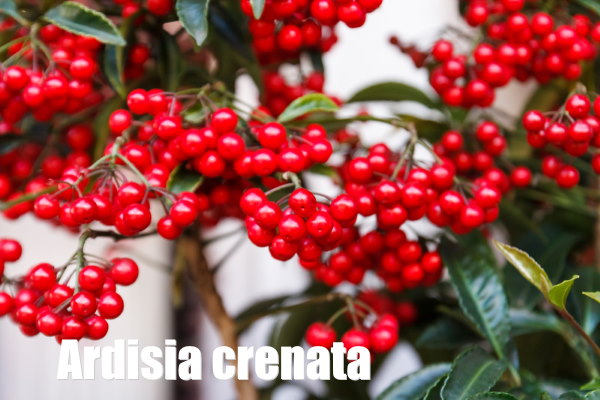Ardisia Crenata
Botanical Name: Ardisia crenata
Like Cinderella dressed for the ball, this evergreen shrub is transformed at Christmastime into a ravishing beauty, spectacularly adorned with red berries.
 Bright berries adorn this shrub in winter, making Ardisia crenata a delightful houseplant.
Bright berries adorn this shrub in winter, making Ardisia crenata a delightful houseplant.About Your Houseplant
This compact, upright shrub can grow to 6 ft in its native tropical habitat, but indoors you can expect it to reach about half that height. Slow-growing, it'll take a while to get there.
Glossy, deep-green leaves grow to 4 in (10 cm) long and about half as wide. Their serrated edges add to the allure of this ornamental plant.
Clusters of petite, white or pale pink flowers grow from the leaf axils on the plant's lower branches in summer. Those lightly fragrant blooms are followed by 1/4-in (6 mm) round berries. Young plants may take 2 years to produce those colorful berries.
Red berries are the real attraction of Ardisia crenata and arrive around Christmas time. You'll enjoy the berries on this shrub until it starts flowering again.
Ardisia Crenata Plant Problems, Solutions and Answers
Got a reluctant bloomer? Give your plant more humidity and sunlight in spring, when it's starting to form buds. Regular misting with room-temperature water will help increase the moisture in the air around it. Misting also helps to keep away spider mites that prefer dry conditions.
Dropping flower buds are likely caused by dry soil or cold air. Ardisia crenata likes it cool, but not too cold. It will tolerate a minimum winter temperature of 45°F/7°C. Keep the plant out of entryways and away from A/C and heat vents.
Wondering when to prune? Prune each spring before flowering, if needed, to shape up this shrub and to keep it compact.
Is it time to repot? When the roots have filled the pot, move up to a pot 1-2 inches (2.5-5 cm) larger. Use a pot with drainage holes because it will not tolerate soggy soil. Wait till late winter or early spring to repot -- never while it's blooming or this beauty may drop its flower buds.
Something bugging your plant? Spider mites are attracted to warm, dry homes in the winter. Watch for these sap-sucking pests on your houseplants. You'll first notice their fine webbing between leaves and stems, as well as dry-looking, mottled foliage. Mealybugs look like white, fuzzy specks along the stems and the undersides of leaves. Treat any infestation immediately to prevent them from destroying your houseplants.
Ardisia Crenata Buying Tips
This decorative shrub isn't easy to find. Few greenhouses stock A. crenata plant because it is considered invasive in warm climates. However, confined to a pot, it makes a fine indoor plant.
A few other shrubs may go by the same common names, Christmas berry, Coral ardisia, Coralberry or Spiceberry. Look for the scientific name Ardisia crenata to be sure you're getting this plant.

Ardisia Crenata Growing Tips
Origin: East Asia
Height: Up to 6 ft (1.8 m) in its native habitat; however, growing in a container indoors, it will slowly reach 3 ft (90 cm).
Light: Bright, indirect light year-round. Some direct morning sunlight is fine, but keep shaded from hot, direct midday sun.
Water: Keep the soil evenly moist year-round, but not soggy which can lead to root rot. Never allow it to dry out, either. It's a good idea to use a moisture meter rather than guess when to water. Also, always use room-temperature water on your tropical houseplants because cold water is a shock to them.
Humidity: These tropical shrubs do best with moderate-to-high (about 50-60%) relative humidity. Homes can become extremely dry in winter; use a cool-mist room humidifier, if necessary.
Temperature: Cool to average room temperatures 45-65°F/7-18°C. Keep Ardisia crenata out of cold drafts from doorways and away from A/C and heat vents.
Soil: Soil-based potting mix
Fertilizer: Feed every 2 weeks from early spring through summer with a balanced (such as 10-10-10) water-soluble fertilizer. In fall and winter, feed monthly.
Propagation: Sow seeds in spring, and be patient -- seeds can take several weeks to germinate. Use sterile seed-starting mix, keep moist, and maintain 70°F/21°C at all times; it's a good idea to use a seedling heat mat to ensure an even temperature. Or take 4-6 in (10-15 cm) stem tip cuttings in spring and place upright in moist peat moss-based potting mix. Cover the plant and pot in a plastic bag to hold in humidity. Propagating this plant is hit-or-miss. Neither method is easy.


